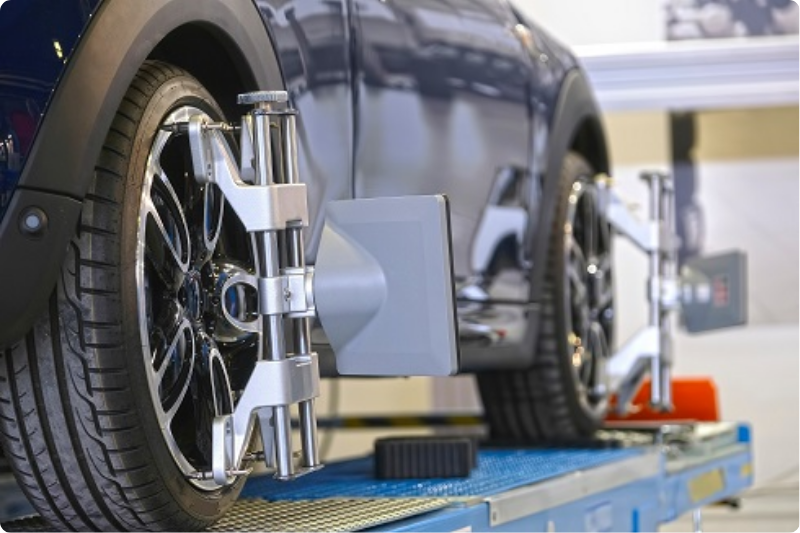Wheel alignment often feels like a small part of vehicle maintenance, but ignoring it can lead to serious problems. It not only damages your tires but also puts your safety at risk every time you drive. Correct alignment ensures your vehicle handles properly, your tires last longer, and you save money on repairs.
In this article, we will clearly explain the critical effects of misalignment on your car and tires, signs you shouldn’t ignore, and why regular alignment checks are essential for a safe and comfortable driving experience.
How Misalignment Affects Your Tires and Vehicle Performance
When your wheels are not properly aligned, every part of your car starts to feel the impact. Misalignment causes tires to wear unevenly, making them less effective and reducing their lifespan. In fact, tires affected by poor alignment often develop bald spots, feathering, or rapid tread wear — patterns that weaken grip on the road and can even lead to blowouts.
Additionally, your car may start pulling to one side, making steering harder to control. Over time, the added stress on your suspension and steering system leads to costly repairs, which could have been avoided with a simple alignment service.
Common Warning Signs That Your Wheels Are Out of Alignment
Knowing the early signs of misalignment can save you a lot of trouble down the road. Some of the most noticeable indicators include:
-
Uneven Tire Wear: If you notice that one side of the tire is more worn than the other, it usually points to misalignment.
-
Steering Wheel Off-Center: If you have to keep the steering wheel tilted to drive straight, that’s a strong hint.
-
Vehicle Pulling to One Side: If your car drifts left or right even when you’re trying to drive straight, alignment could be the issue.
-
Vibrations While Driving: Misaligned wheels can cause steering wheel vibrations, especially at higher speeds.
-
Decreased Fuel Efficiency: When wheels are not aligned, the engine must work harder to keep the car moving, leading to higher fuel consumption.
Ignoring these signs only worsens the problem and increases both safety risks and repair costs.
The Serious Consequences of Ignoring Misalignment
Driving with misaligned wheels doesn’t just wear out your tires faster — it compromises your entire driving experience. Here’s how:
-
Tire Damage: Misaligned wheels grind your tire tread unevenly, forcing you to replace tires much sooner than normal.
-
Steering and Suspension Stress: Extra strain on these systems increases the chance of mechanical failures, especially during sharp turns or emergency stops.
-
Reduced Safety: Poor alignment affects how your car responds to steering, particularly in slippery or emergency situations. It could mean the difference between avoiding a collision or not.
-
Higher Fuel Costs: Misalignment forces your car to use more energy to move forward, burning more fuel over time.
Maintaining proper alignment not only preserves your car but also protects everyone inside it.
Everyday Factors That Lead to Misalignment
You might be surprised at how easily a car can fall out of alignment. Some common causes include:
-
Hitting Potholes: Even a single impact can knock wheels out of position.
-
Bumping Into Curbs: Parking accidents or tight turns can disturb the alignment settings.
-
Normal Wear and Tear: As suspension components age, they naturally shift slightly, affecting alignment.
-
Carrying Heavy Loads: Excess weight can put pressure on the suspension, leading to misalignment.
Understanding these causes helps you be more cautious and proactive with your car’s maintenance.
Why Regular Alignment Checks Are Essential
Many drivers assume they only need alignment after a big accident, but regular inspections should be part of your vehicle’s normal care routine. Getting your alignment checked every 10,000 to 12,000 miles — or once a year — helps catch small issues before they turn into expensive repairs.
A professional alignment service uses laser-guided tools to measure the exact angles of your wheels, adjusting them to match factory specifications. This process improves driving performance, extends tire life, and provides better fuel efficiency.
How to Choose the Right Alignment Service
When selecting a repair shop, it’s important to look for technicians who specialize in wheel alignment and use advanced alignment machines. Precision tools and expert knowledge make a big difference in how well your vehicle will drive afterward.
Look for places that offer a detailed alignment report before and after service, showing exactly what was corrected. This transparency ensures you’re getting quality service that protects your investment in your car.
Conclusion: Small Adjustments, Big Protection
Alignment may seem like a minor maintenance task, but its impact on safety, performance, and tire health is major. Paying attention to early signs, getting regular checks, and trusting skilled professionals can help you avoid costly repairs and dangerous driving conditions.
Proper alignment is an easy step that leads to smoother rides, safer roads, and longer-lasting tires — a win for you, your car, and everyone you share the road with.


